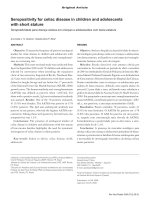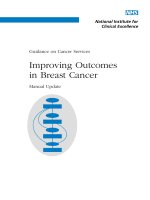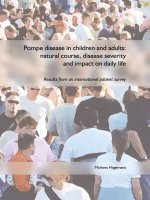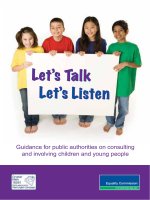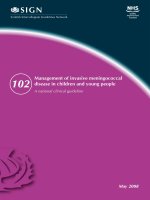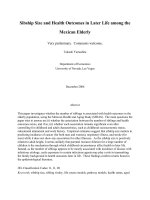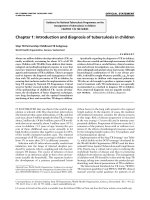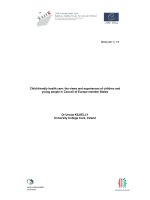Guidance on Cancer Services - Improving Outcomes in Children and Young People with Cancer pptx
Bạn đang xem bản rút gọn của tài liệu. Xem và tải ngay bản đầy đủ của tài liệu tại đây (456.2 KB, 198 trang )
Guidance on Cancer Services
Improving Outcomes in
Children and Young People
with Cancer
The Manual
August 2005
Developed by the National Collaborating Centre for Cancer
National Institute for
Health and Clinical Excellence
NHS
Improving Outcomes in Children and Young People with Cancer
Cancer service guidance supports the implementation of
The NHS Cancer Plan
for England,
1
and the NHS Plan for
Wales
Improving Health in Wales.
2
The service guidance programme was initiated in 1995 to follow on from the
Calman–Hine Report,
A Policy Framework for Commissioning Cancer Services.
3
The focus of the cancer service
guidance is to guide the commissioning of services and is therefore different from clinical practice guidelines.
Health services in England and Wales have organisational arrangements in place for securing improvements in
cancer services and those responsible for their operation should take this guidance into account when planning,
commissioning and organising services for cancer patients. The recommendations in the guidance concentrate on
aspects of services that are likely to have significant impact on health outcomes. Both the objectives and resource
implications of implementing the recommendations are considered. This guidance can be used to identify gaps in
local provision and to check the appropriateness of existing services.
References
1. Department of Health (2001)
The NHS Cancer Plan
. Available from: www.dh.gov.uk
2. National Assembly for Wales (2001)
Improving Health in Wales: A Plan for the NHS and its Partners.
Available from: www.w
ales.gov.uk/healthplanonline/health_plan/content/nhsplan-e.pdf
3.
A Policy Framework for Commissioning Cancer Services
:
A Report by the Expert Advisory Group on
Cancer to the Chief Medical Officers of England and Wales
(1995). Available from: www
.dh.gov.uk
National Institute for
Health and Clinical Excellence
MidCity Place
71 High Holborn
London
WC1V 6NA
Web: www
.nice.org.uk
ISBN: 1-84629-067-8
Copies of this document can be obtained from the NHS Response Line by telephoning 0870 1555 455 and quoting
reference N0897. Information for the public is also available from the NHS Response Line (reference number
N0899). A CD-ROM with all documentation, including the research evidence on which the guidance is based, is
available from the NHS Response Line (reference N0898).
Published by the National Institute for Health and Clinical Excellence
August 2005
© National Institute for Health and Clinical Excellence, August 2005. All rights reserved. This material may be freely
reproduced for educational and not-for-profit purposes within the NHS. No reproduction by or for commercial
organisations is permitted without the express written permission of the Institute.
Guidance on Cancer Services
Improving Outcomes in
Children and Young
People with Cancer
The Manual
August 2005
Developed by the National Collaborating Centre for Cancer
Guidance on cancer services: cancer in children and young people
Contents
Foreword 5
Key recommendations 7
1 Background 9
Introduction 9
Principles 9
Challenges 10
Epidemiology 13
Registration 13
Classification 13
Aetiology 14
Incidence 14
Trends 15
Comparison of incidence with other countries 16
Variation of incidence with age 17
Mortality 17
Survival 18
Prevalence 19
Late effects 19
Key points 20
Current services 21
Cancer treatment 21
Supportive and palliative care 22
Service use 22
Inpatient care 22
Day case care 23
1
Improving Outcomes in
Children and Young
People with Cancer
Procedures 24
Palliative care 24
Allied health services 24
Non-health services 25
References 25
2 The care pathway 27
Presentation and referral 28
Diagnosis 31
Pathology 31
Imaging 32
Treatment 37
Chemotherapy 37
Surgery 41
Neurosurgery 44
Radiotherapy 47
Supportive care 52
Febrile neutropenia 52
Central venous access 55
Blood product support 58
Pain management 59
Management of nausea, vomiting and bowel disturbance 61
Nutrition 63
Oral and dental care 65
Rehabilitation 68
Psychosocial care 73
Long-term sequelae 77
Palliative care 81
Bereavement 87
2 National Institute for Health and Clinical Excellence
Improving Outcomes in
Children and Young
People with Cancer
Contents
3 Service organisation 90
Delivery of care 91
Multidisciplinary teams 91
Continuity of care 97
Protocol-based care 100
Place of care 103
Principal treatment centres 103
Hospitals with shared care arrangements 105
Other locations of care 106
Cancer networks 117
Communication with children, young people
and families
119
Research 123
Workforce development 127
Other service considerations 130
Information requirements 130
Child protection 130
Education 131
Hospital facilities 131
Hospital parking 132
Appendices
Appendix 1:
Guidelines/guidance and key strategic documents:
children and young people with cancer
133
Appendix 2:
Scope of the guidance
145
Appendix 3:
United Kingdom Children’s Cancer Study Group
Centres and Teenage Cancer Trust Units in
England and Wales
152
Appendix 4:
Economic implications of the guidance
155
3
Guidance on cancer services: cancer in children and young people
Improving Outcomes in
Children and Young
People with Cancer
Contents
Appendix 5:
How this guidance manual was produced
161
Appendix 6:
People and organisations involved in production
of this guidance
164
Appendix 7:
Glossary of terms
180
Appendix 8:
Abbreviations
193
4 National Institute for Health and Clinical Excellence
Improving Outcomes in
Children and Young
People with Cancer
Contents
Guidance on cancer services: cancer in children and young people
5
Foreword
This guidance is the latest in the Improving Outcomes in Cancer
series and is the first to be produced by the National Collaborating
Centre for Cancer (NCC-C). Developing this guidance gave particular
challenges, not only because it was the first work of a new
organisation and there was a very high standard to live up to, but
also because of the special features of the topic. Whereas most of the
previous guidance has dealt with a well-defined tumour type, this
guidance deals with the service provision for a group of cancer
patients defined not by the characteristics of the tumour, but by their
age. This led very early on, when we were consulting on the draft
scope for the guidance, to a problem of definition.
The original title of the guidance was Child and Adolescent Cancer.
When consulting on the draft scope it was soon clear that setting an
arbitrary upper age limit was unacceptable. As a result the title and
the scope have been changed to include children and young people
with cancer in their late teens and early twenties. This is not just a
cosmetic change, but reflects some important principles that we hope
are clear in the guidance.
During the development of this guidance there have been changes in
the structure of the NHS in England and its commissioning
arrangements, with the introduction from 1 April 2005 of Payment by
Results. It is not yet clear what effect this will have on the way in
which service guidance of this kind is implemented.
I should like to acknowledge the great commitment and hard work of
the chair, Dr Cerilan Rogers, the lead clinician, Dr Meriel Jenney, and
all the members of the Guidance Development Group, who gave of
their time willingly to this project, with the shared belief that this
guidance provides an opportunity to improve the care of an
especially vulnerable group of patients. We are all grateful to a
number of other experts, acknowledged in Appendix 6.4, who
provided written papers or informal advice to the group, and without
whom this guidance would have been incomplete.
Improving Outcomes in
Children and Young
People with Cancer
I would like to thank all the children and teenagers with cancer, and
their siblings and parents, who contributed their valuable opinions to
the research carried out by the National Children’s Bureau and the
Teenage Cancer Trust on our behalf. Without their commitment the
guidance would have been incomplete.
I hope that the guidance will provide an acceptable blueprint to the
NHS in England and Wales, and lead to significant and lasting
changes to the care of children and young people with cancer that
improve not only the clinical outcomes, but also the experience of
the patients and their families.
Dr Fergus Macbeth
6 National Institute for Health and Clinical Excellence
Improving Outcomes in
Children and Young
People with Cancer
Foreword
Guidance on cancer services: cancer in children and young people
Key recommendations
•
Planning, commissioning and funding for all aspects of care for
children and young people with cancer, across the whole
healthcare system, should be coordinated to ensure that there is
an appropriate balance of service provision and allocation of
resources. The principle that underpins the guidance is that of
age-appropriate, safe and effective services as locally as possible,
not local services as safely as possible.
•
Commissioners should ensure, through cancer networks in
partnership with services for children and young people, that:
–
there is a clear organisational structure for these services,
including a cancer network lead for children with cancer
and a cancer network lead for young people with cancer
–
all aspects of care for children and young people with
cancer should be undertaken by appropriately trained staff
–
principal treatment centres for each cancer type are
identified for children and for young people, with
associated referral pathways, including to centres outside
the network of residence when necessary
–
principal treatment centres are able to provide a
sustainable range of services, with defined minimum levels
of staffing, as outlined in the guidance
–
shared care arrangements are established, which identify a
lead clinician and lead nurse and have approved clinical
protocols for treatment and care, and defined areas of
responsibility with the principal treatment centres
–
all sites delivering cancer therapy in this age group should
be subject to peer review
–
all relevant national guidance is followed (see Appendix 1).
•
Care should be delivered throughout the patient pathway by
multidisciplinary teams (MDTs), including all relevant specialist
staff. Membership and governance of these teams should be
explicit and include clearly defined responsibility for clinical and
managerial leadership.
7
Improving Outcomes in
Children and Young
People with Cancer
•
Appropriately skilled, professional key workers should be
identified to support individual children and young people, and
their families, by:
–
coordinating their care across the whole system and at all
stages of the patient pathway
–
providing information
–
assessing and meeting their needs for support.
•
All care for children and young people under 19 years old must
be provided in age-appropriate facilities [35, Appendix 1]. Young
people of 19 years and older should also have unhindered
access to age-appropriate facilities and support when needed.
All children and young people must have access to tumour-
specific or treatment-specific clinical expertise as required.
•
Theatre and anaesthetic sessional time should be adequately
resourced for all surgical procedures, including diagnostic and
supportive procedures, in addition to other definitive tumour
surgery. Anaesthetic sessional time should also be assured for
radiotherapy and painful procedures. The paediatric surgeon
with a commitment to oncology should have access to
emergency theatre sessions during routine working hours.
•
All children and young people with cancer should be offered
entry to any clinical research trial for which they are eligible and
adequate resources should be provided to support such trials.
Participation in trials must be an informed choice.
•
Children and young people with cancer who are not
participating in a clinical trial should be treated according to
agreed treatment and care protocols based on expert advice, and
resources provided to monitor and evaluate outcomes.
•
The issues related to the registration of cancers in 15–24-year-
olds and the potential value of a dedicated register within the
structures of the National Cancer Registries should be addressed
urgently.
•
The need for trained specialist staff across all disciplines, able to
work with children and young people with cancer, should be
included in workforce development plans by cancer networks,
to ensure the provision of a sustainable service.
•
Specific attention is required to address the shortage of allied
health professional expertise in this area and the evaluation of
the contribution of such services.
8 National Institute for Health and Clinical Excellence
Improving Outcomes in
Children and Young
People with Cancer
Key recommendations
Guidance on cancer services: cancer in children and young people
Background
Introduction
The purpose of this guidance is to provide recommendations on
service provision for children and young people with malignant
disease, based on the best available evidence. It is primarily for
commissioners of services, but has equal relevance for service
providers.
There are many other current national initiatives of relevance, not
least national service frameworks (NSFs) and other Improving
Outcomes guidance; care has been taken not to duplicate this work,
but adherence to such guidance is expected. The guidance also
assumes compliance with the relevant national guidelines on the
administration/management of therapies (see Appendix 1) and any
relevant legal frameworks.
The population, healthcare settings, and services and key areas of
clinical management are included in detail in the Scope (see
Appendix 2). The guidance covers children from birth and young
people in their late teens and early twenties presenting with
malignant disease, and the whole range of NHS services required to
meet their needs. These needs are influenced by a complex
interaction between the condition, stage in the care pathway and
individual maturity. The guidance has not used a specific upper age
limit in the recommendations, other than for the children’s NSF,
recognising that any such limit would be arbitrary and that services
should be appropriate for individual needs.
Principles
Certain principles were adopted by the Guidance Development Group
(GDG) in considering their recommendations:
•
these should be evidence-based
•
the aim is for safe and effective services as locally as possible, not
local services as safely as possible
9
Improving Outcomes in
Children and Young
People with Cancer
1
•
an integrated, whole systems approach to these services is
essential
•
there needs to be a sustainable balance between centralisation and
decentralisation.
Challenges
There were challenges in the development of this guidance. The
potential material for inclusion was vast and the Group have tried to
focus on those aspects of the service that are likely to have a significant
impact on health outcomes.
Types of cancer
There is a wide range of conditions, which for convenience are
grouped into three categories: solid tumours, haematological
malignancies and central nervous system (CNS) malignancies. A care
pathway approach has been used (see Figure 1) to ensure inclusion of
the main clinical issues affecting services.
Service organisation
Many issues are not condition specific, but involve the way services are
delivered and/or organised, and are dealt with in the section on service
organisation. Some areas, such as data protection, child protection and
staff training, are also addressed in the section on service organisation in
the guidance.
10 National Institute for Health and Clinical Excellence
Improving Outcomes in
Children and Young
People with Cancer
Background
1
Guidance on cancer services: cancer in children and young people
11
Improving Outcomes in
Children and Young
People with Cancer
Background
1
Treatment settings
Psychological
services
Communication
Continuity of care
Staff training
Child protection
Research
Patient
information
Data protection
Social
and
family
support
Education
services
Ethics
Epidemiological
information
Audit
Presentation Referral Diagnosis
Shaded area =
care pathway
Supportive care Treatment Allied
treatment
services
Survivors Rehabilitation Palliative care
Follow-up
Figure 1 The care pathway for children and young people with cancer and its wider context.
Definition of children and young people
There are various definitions of the boundary between childhood and
adulthood used by society, some of which define a legal entitlement
or access to services. Children are recognised as different because they
are, both in terms of their needs and the disorders they experience.
Their needs differ according to their developmental stage (emotional,
social, psychological and physical) and the group covered by this
guidance is therefore heterogeneous.
Indeed, across the age spectrum, children are as different from each
other as they are from adults. The guidance is based around three
main groups – children, teenagers and young adults – although the
term ‘young people’ is used throughout when it is unnecessary to
differentiate between teenagers and young adults.
Age range
Very different issues arise depending on the age and maturity of the
individuals whose needs are being addressed. Childhood and
adolescence is a time of enormous change, physically, psychologically
and socially, and this influences the different patterns of malignancy
seen, their pathological behaviour, response to treatment and eventual
outcomes. The truism that outcomes encompass more than improved
health, in terms of survival, mortality and morbidity, is even more of a
reality for children, whose outcomes need to include the ability to
mature successfully into adulthood. The late effects of treatment are
particularly relevant in this context.
Families
The dependence of children and young people on their families and
the profound effect severe ill health and/or death of a child or young
person has on other family members are additional important factors
that significantly affect all service planning and delivery.
Sources of evidence
A number of relevant existing guidelines and reviews were accessed
(see Appendix 1 and the Evidence Review).
Searches of various databases were undertaken in response to specific
questions formulated by the Group (methodology outlined in the
Evidence Review).
A nominated panel of experts was invited to contribute via the
submission of formal position papers for consideration by the GDG
(see Appendix 6.4 and the Evidence Review).
Specific work was commissioned to elicit the views of children and
young people with cancer, and their siblings and parents, on current
service provision. This study was performed by the National Children’s
Bureau (NCB) and is available in Appendix D of the Evidence Review.
12 National Institute for Health and Clinical Excellence
Improving Outcomes in
Children and Young
People with Cancer
Background
1
Guidance on cancer services: cancer in children and young people
In addition, the results of a survey of teenagers’ views on the
provision of cancer services, from a conference organised by the
Teenage Cancer Trust (TCT) in 2004 (see Appendix E of the Evidence
Review), were used to provide information on the specific
requirements of this age group.
Where there was no substantial evidence-base for important key
questions, consensus methods were used by the GDG.
Epidemiology
The guidance development was supported by a needs assessment
exercise, covering both England and Wales, undertaken by the
National Public Health Service for Wales; some of this is included
below. The full assessment is included in the Evidence Review.
Registration
Registration of cancer cases is voluntary. There are nine population-
based regional cancer registries in England. The Welsh Cancer
Intelligence and Surveillance Unit has responsibility for cancer
registrations on behalf of the Welsh Assembly Government. The
National Cancer Intelligence Centre at the Office for National Statistics
(NCIC-ONS) collates cancer registration data nationally for England,
Wales and Scotland. All registries systematically collect data from a
number of sources to maximise completeness and accuracy. In
addition, the National Registry of Childhood Tumours (NRCT) in
Oxford registers cases of malignancy in children under the age of 15
years. There is no comparable dedicated national register of cancer
cases occurring between the ages of 15 and 24 years.
Classification
NCIC-ONS data are coded using the International Classification of
Diseases system (ICD) version 10. This is based on a topographical
description of tumour site and allows detailed coding of adult tumours.
Cancers that develop in childhood are different from those in adult life.
There is increased histological diversity and many tumours develop from
embryonal tissue. The ICD is less able to code these tumours accurately,
so an alternative classification based on histological characteristics has
been developed. This alternative system, the International Classification
of Childhood Cancer (ICCC), is used by the NRCT.
The needs assessment conducted for this Guidance was required to use
ICCC. The existence of the two coding systems caused delays in data
collection. Data for the 0–14-year-old age group were received from
NRCT and were coded in ICCC. To allow production of comparable
analyses of incidence in the 15–24-year-old age groups, the ICD-coded
13
Improving Outcomes in
Children and Young
People with Cancer
Background
1
NCIC-ONS data had to be converted into ICCC. As there is no nationally
agreed conversion table between these systems, this process took time.
ICCC-coded prevalence, mortality and survival data were not available
for the 15–24-year-old age group within the time available.
Aetiology
The identified risk factors for child and adolescent cancers account for
only a minority of cases, so there is limited potential for preventive
interventions. The identified risk factors for childhood cancer include
genetics, infections, hormones and radiation.
1
Incidence
Cancers in children aged less than 15 years old are rare, causing less
than 1% of all cancers in industrialised countries.
1
Data from
1981–1990
2
suggest an age-standardised annual incidence in England
and Wales of 122 per million children. The NRCT gives a figure of
133.7 per million (for data between 1988 and 1997), but this includes
a small number of non-malignant diagnoses.
The most common diagnoses are leukaemia (42.9 per million), brain
and spinal neoplasms (31.4 per million) and lymphoma (12.0 per
million). The least common diagnosis in this age group is hepatic
tumour (1.3 per million).
Figure 2 Comparison of age-standardised incidence rates
between the International Classification of Childhood
Cancers (ICCC) groups and non-malignant conditions
in children aged 0–14 years, per million population at
risk (1988–1997).
ICCC groups
3
I. Leukaemia; II. Lymphoma and reticuloendothelial neoplasms; III. CNS and miscellaneous
intracranial and intraspinal neoplasms; IV. Sympathetic nervous system tumours; V.
Retinoblastoma; VI. Renal tumours; VII. Hepatic tumours;VIII. Malignant bone tumours; IX.
Soft tissue sarcomas; X. Germ-cell, trophoblastic and other gonadal neoplasms; XI.
Carcinomas and other malignant epithelial neoplasms; XII. Other and unspecified malignant
neoplasms. LCH – Langerhans cell histiocytosis; Fib – fibromatosis.
14 National Institute for Health and Clinical Excellence
Improving Outcomes in
Children and Young
People with Cancer
Background
1
Age-standardised rate per million
50
40
30
20
10
0
ICCC group
IIIIII IV V VI VII VIII IX X XI XII LCH Fib
Guidance on cancer services: cancer in children and young people
15
In 15–24-year-olds, ONS data from 1988–1997 give an overall age-
standardised rate of 213.9 per million. The most common diagnoses
include carcinoma and epithelial neoplasms (53.1 per million), and
lymphomas (49.7 per million). The least common diagnosis was
retinoblastoma.
Figure 3 Comparison of age-standardised incidence rates
between the International Classification of Childhood
Cancers (ICCC) groups in persons aged 15–24 years
old, per million population at risk (1988–1997).
For details of ICCC groups, see Figure 2. Source: Office of National Statistics.
The Scotland and Newcastle Lymphoma Group (SNLG) database
4
provides additional information for 15–24-year-olds diagnosed
between 1994 and 2002 inclusive. There were 282 cases of Hodgkin’s
lymphoma, of which 51% were in males. The median age at
diagnosis was 21 years. For non-Hodgkin’s lymphoma there were 114
cases (57% in males, median age at diagnosis 20 years). These data
apply to the population of Scotland and the north of England.
Trends
An increase in the incidence of childhood and adolescent cancers has
been demonstrated for a wide range of diagnoses. A study examining
trends in childhood malignancy in the north-west of England
(1954–1988) identified significant linear increases in acute
lymphoblastic leukaemia and Hodgkin’s disease.
5
Additional
investigation identified a significant increase in chronic myeloid
leukaemia. A related study found significant linear increases in
juvenile astrocytoma in males, medulloblastoma and neuroblastoma
in females, and non-skin epithelial tumours overall.
6
Improving Outcomes in
Children and Young
People with Cancer
Background
1
Age-standardised rate per million
50
40
30
20
10
0
ICCC group
IIIIII IV V VI VII VIII IX X XI XII
60
16
In 15–24-year-olds, there have been significant increases in incidence
from 1979 to 1997 across all diagnostic groups.
7
Significant increases
occurred in the incidence of gonadal germ cell tumours, melanoma
and carcinoma of the thyroid. Smaller increases occurred for
lymphomas, CNS tumours, acute myeloblastic leukaemia and
genitourinary tract carcinomas. Incidence rates calculated for this
report show a rise in the incidence of carcinomas and epithelial
neoplasms in the 20–24-year-age group that has resulted in this group
replacing lymphoma as the most common group overall (ONS).
Comparison of incidence with other countries
The Automated Childhood Cancer Information System (ACCIS)
publishes comparative incidence data from European Cancer
Registries. The 5-year (1993–1997) world-standardised incidence rate
of all childhood cancers in England and Wales of 133.7 cases per
million children is similar to rates in other European countries (Table
1). The incidence rates range from 127.3 per million in Ireland to
170.4 per million in Finland. Comparable data for adolescents and
young adults are not available.
Table 1 Five-year world-standardised incidence rates in
0–14-year-olds per million population at risk for all
tumours for selected European countries (1993–1997).
Improving Outcomes in
Children and Young
People with Cancer
Background
National Institute for Health and Clinical Excellence
Country World-standardised
incidence rate
Ireland
a
127.3
Scotland 130.1
Germany 130.9
Hungary 132.4
England and Wales
b
133.7
The Netherlands
c
138.9
Northern Ireland
d
141.6
Spain
c
143.7
Iceland 147.2
Norway 151.6
Denmark 158.1
Finland 170.4
Source: Automated Childhood Cancer Information System
a
Data collection 1994–1997
b
Data collection 1988–1997
c
Data collection 1993–1995
d
Data collection 1993–1996
1
Guidance on cancer services: cancer in children and young people
17
Variation of incidence with age
The incidence of malignancy varies with age, with a peak in the first
5 years of life
1
and lowest incidence in those aged 8–10 years.
8
Cancer is more common in adolescents (aged 15–19 years) than in
children, with a reported incidence of 150–200 per million.
8
In young
adults aged 20–24 years, the incidence is higher again at 226 per
million.
7
The type of malignancy also varies with age. Leukaemias, and brain
and spinal tumours, are the most common malignancies of childhood
1
(NRCT). Epithelial neoplasms and lymphomas are the most common
presentations in young adults and there is an increasing frequency of
germ cell tumours and melanoma in this age group
7
(ONS).
For most malignancies of childhood, the incidence is greater in boys
than girls with an overall ratio of 1.2:1.0.
2
Malignancies more common
in girls include malignant melanoma and cancers of the breast, thyroid
and genitourinary tract.
7
Mortality
The highest mortality occurs in the diagnostic groups with highest
incidence. Therefore in those aged 0–14 years, the leukaemias are the
most common cause of death (30.7%). However, the relative
frequencies in mortality between the ICCC groups is different from the
relative frequencies in incidence because of variation in survival rates.
For example, sympathetic nervous system tumours contribute 6.7% of
new childhood cancer cases, but account for 12.3% of deaths due to a
poor survival rate. In contrast, retinoblastoma causes 3.2% of new
cases, but only 0.8% of deaths, suggesting a favourable survival rate.
Improving Outcomes in
Children and Young
People with Cancer
Background
1
Figure 4 Comparison of age-standardised mortality rates
between the International Classification of Childhood
Cancers (ICCC) groups and non-malignant conditions
in persons aged 0–14 years, per million population at
risk (1988–1997).
For details of the ICCC groups, see Figure 2. Source: National Registry of Childhood Tumours.
There are no ICCC-coded mortality data available for 15–24-year-olds.
Using ICD-10-coded ONS data, the overall age-standardised mortality
rate for 0–24-year-olds is 41.4 per million (37.6 per million in the 0–14
year age groups [NRCT]; higher in the older age group).
Survival
There have been remarkable improvements in the survival rates from
most childhood malignancies over the past 30 years, with the overall
survival rates in England and Wales for those diagnosed between 1993
and 1997 estimated to be 75% (source: NRCT). The probability of
survival varies with diagnosis. A lower survival rate is achieved, for
example, in certain classes of brain and spinal tumours (43%), chronic
myeloid leukaemia (44%) and neuroblastoma (55%), whilst 100%
survival is reported for thyroid carcinoma.
Improvement in survival rates has been attributed to advances in
treatment and supportive care, centralising treatment to specialist
centres and the inclusion of the majority of patients in national and
international trials,
1,9
which has resulted in protocol-based management.
18 National Institute for Health and Clinical Excellence
Improving Outcomes in
Children and Young
People with Cancer
Background
1
Age-standardised rate per million
10
8
6
4
2
0
ICCC group
12
IIIIII IV V VI VII VIII IX X XI XII LCH Fib
Guidance on cancer services: cancer in children and young people
The paediatric section of the Eurocare 3 report
10
allows comparison
of survival rates between 20 European countries in children aged less
than 15 years at the time of diagnosis. It reports the weighted 5-year
survival rate in England and Wales for those diagnosed between 1990
and 1994 to be 71.1%. This is higher than the Eastern European
countries where the survival rate is reported to be between 63% and
66%, but lower than in Germany, Switzerland and the Nordic
countries (except Denmark) where mean survival rate is 80%. ACCIS
also publishes comparative survival data from European registries for
those aged 0–14 years diagnosed between 1993 and 1997. This source
quotes an overall survival rate of 73% for England and Wales,
compared with 66% in Hungary and 81% in Iceland. This value for
England and Wales is not significantly different from that in other
European countries, apart from Finland and Germany. The differences
in survival rates reported by both sources may partly be due to
differences in the registration and reporting of malignancies within
population-based registries. However, they may also reflect true
differences in outcome.
National-level survival data and comparative European survival data
for 15–24-year-olds have not been published.
Prevalence
The prevalence of disease is dependent upon the underlying
incidence of disease and rates of survival. Increasing incidences of
some diseases and overall improvements in survival rates are leading
to an increasing population of children and young adults who have
survived malignant disease.
Among children aged 0–14 years, leukaemia is the most common
diagnosis, accounting for 35.4% of cases (age-standardised rate 271.4
per million); brain and spinal neoplasm cases account for 20% (151.9
per million) and renal cases 8.5% (66.6 per million). These relative
proportions show a difference from incidence data, reflecting the
differing survival rates between disease groups.
Late effects
With increasing survival, the physical, emotional and social sequelae,
which may impair the quality of life in the long term, become more
important. Although many of those cured of cancer during childhood
or young adulthood will return to good health, others will experience
significant late sequelae. These sequelae can occur at any time during
or following completion of therapy. They include problems such as
impairment of endocrine function (for some including infertility,
abnormal growth and development or bone mineral accretion),
cardiac and neurological impairment, cognitive decline (for example,
following treatment for tumours of the CNS) and psychological effects
19
Improving Outcomes in
Children and Young
People with Cancer
Background
1
and increased risk of developing a second cancer.
11
On average, 4%
of childhood cancer survivors develop a second primary malignancy
within 25 years of diagnosis,
11
although for certain diagnoses this
figure is higher.
12
Radiotherapy is a particular risk factor.
11,13
The risk
of second malignancy, which can occur many years after the primary
diagnosis, is estimated to be between four and six times the risk in
the general population.
11,13
Key points
Cancers in children and young people are rare, with an annual
rate of new cases of 133.7 per million in those aged 0–14 years
and 213.9 per million in those aged 15–24 years.
Cancers in children and young people show a characteristic
pattern of incidence that changes with increasing age. Leukaemia,
and brain and spinal neoplasms, are the most common diagnoses
in the 0–14-year-old age group. Carcinomas and epithelial
neoplasms and lymphomas are the most common in the 15–24-
year-old age group.
Overall survival rate is high (currently 75% in 0–14-year-olds),
although disease-specific survival rates vary.
Improved survival rates are contributing to the increase in absolute
numbers of survivors of childhood cancer, which has implications
for service provision.
Although cancers in children and young people are rare, death
from all causes is rare in these age groups, so cancer remains a
very important cause of death in children and young people.
Issues of differential coding and data collection systems between
those aged 0–14 years and those aged 15–24 years hampers the
calculation of comparable rates and therefore definition of need in
this population. For the purpose of producing comparative
epidemiological analyses, synchronising the two coding systems
would be ideal.
20 National Institute for Health and Clinical Excellence
Improving Outcomes in
Children and Young
People with Cancer
Background
1
Guidance on cancer services: cancer in children and young people
21
Current services
Information on service availability is drawn from the results of a
survey of United Kingdom Children’s Cancer Study Group (UKCCSG)
treatment centres and TCT units (see Evidence Review).
Cancer treatment
In England and Wales, care of children with cancer is offered and
coordinated at 17 centres registered by the UKCCSG (see Appendix
3.1). Some children’s centres have dedicated adolescent beds and
there are also eight TCT units (see Appendix 3.2), which offer
separate facilities for young people that are appropriate to their age.
Shared care centres are based in secondary care facilities and are
affiliated to UKCCSG centres. The provision of services at shared care
centres varies from initial diagnosis only to greater involvement in
the delivery of care for children and young people with cancer.
All TCT units and UKCCSG centres responded to the survey of child
and adolescent services. Eighteen responses are recorded as some
units and centres responded under a single corporate heading.
A follow-up questionnaire (on allied health services) was sent to
UKCCSG centres only, to which 17 of the 18 centres replied.
The results show that most centres have clinical oncology support,
but only a minority have radiotherapy services delivered on site.
Bone marrow transplantation services are changing, as a minimum
number of procedures are now recommended to maintain clinical
skills in a unit. Many centres undertake allogeneic bone marrow
transplantation; others refer cases, as necessary, to a Joint
Accreditation Committee International Society for Cellular
Therapy–European Group for Blood and Marrow Transplantation
(JACIE)-accredited centre. Eight of the 18 responses recorded access
to paediatric neurosurgery services on site or within an 8-mile radius.
Most centres offer a range of allied health services such as specialist
pharmacy, physiotherapy, occupational therapy and pain
management, although access to these services may be limited.
Centres refer patients out of region for specialised services such as
bone or sarcoma surgery, retinoblastoma assessment, and liver and
thyroid services.
Improving Outcomes in
Children and Young
People with Cancer
Background
1
Supportive and palliative care
All centres have access to at least one children’s hospice, but 13
reported that their patients ‘rarely’ or ‘never’ used this or the adult
hospice service. Seven of the 18 centres offer 24-hour home visit and
telephone advice for those requiring palliative care. The levels of
staffing in palliative care vary considerably between units, though the
survey did not express staff numbers as a ratio to new patients seen.
When asked to identify areas for improvement, centres suggested
increased occupational therapy, psychology, psychiatry and social
worker support as particular service needs.
Service use
Use of services is measured by routinely collected hospital activity
data. Between 1998/9 and 2001/2, there were an annual average of
3.7 total episodes per 1000 children and young people aged 0–24
years. Hospital episode rates decline with age, with the highest rates
in the 0–4-year-old age group (5.0 per thousand children aged 0–4
years, 2001–2002) and lowest in 20–24-year-olds (2.7 per 1000).
There is a trend of increasing overall activity (1995/6 to 2001/2),
which may, in part, reflect improved data collection. More intensive
and complex treatments, greater use of clinical trial protocols, higher
incidence of complications and improved survival rates all
compound to increase activity levels. The data quality is poor in
1997/8 as a result of substantial under-recording of activity (B Cottier:
personal communication 2004). Inpatient and day case activity are
described below.
Inpatient care
The highest inpatient bed-days rates are in the youngest age group
(10.7 per 1000 children aged 0–4 years, 2001/2), reflecting the higher
incidence of cancer in this group. Rates fall in 5–9- and 10–14-year-
olds, but rise again from age 15 years (Figure 5). Overall, there is
little trend in inpatient bed-days rates, except for a possible upward
trend in the 0–4-year-olds. The mean number of inpatient bed-days
between 1998/9 and 2001/2 was 82,000 per annum in 0–14-year-olds,
28,700 per annum in 15–19-year-olds and 25,000 per annum in
20–24-year-olds.
22
Improving Outcomes in
Children and Young
People with Cancer
Background
National Institute for Health and Clinical Excellence
1
